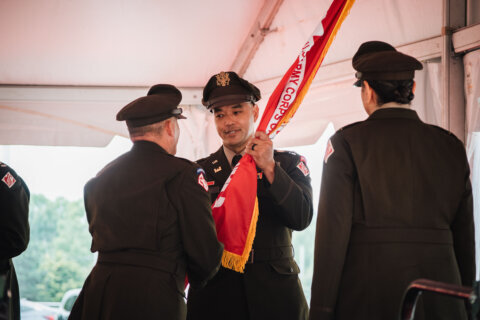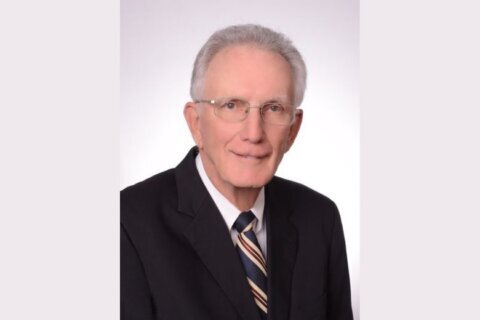BALTIMORE (AP) — As the trial opened Tuesday for a man accused in the deadly shooting ambush of a Baltimore police officer, the motive in the killing remains shrouded in mystery more than two years later.
Officer Keona Holley, who was shot multiple times while sitting in her marked patrol car during an overnight shift, died in the hospital following the December 2021 attack. Police arrested two men who allegedly shot Holley before authorities say they committed another homicide about 90 minutes later in a different Baltimore neighborhood.
One of the suspects, Elliot Knox, is on trial this week for his role in both shootings. Police detained Knox, 34, after identifying him as the owner of a car seen leaving the scenes. He then gave a statement to detectives in which he admitted to some involvement but identified another man as the shooter: Travon Shaw, who would become Knox’s co-defendant.
During opening statements in Knox’s trial Tuesday morning, defense attorney Natalie Finegar said his account was credible because key elements of his confession have been corroborated by other evidence; for example, detectives recovered weapons after he told them where to look. Knox should be found guilty of accessory after the fact and illegal gun possession, not murder, Finegar told the jury.
Shaw was convicted in October of murder and other charges for his role in the second shooting, but he hasn’t yet been tried in Holley’s killing. The second victim, Justin Johnson, was also sitting in his parked car when he was shot.
During emotional testimony about the morning of Johnson’s death, his partner said he was close friends with Shaw. But detectives said repeatedly during Knox’s interrogation that they hadn’t uncovered any relationship between him and either of the victims.
Several hours of testimony from detectives and other witnesses did little to shed light on why Knox would have participated in either of the shootings.
Sgt. Dominic Crawford, an officer who worked alongside Holley in Baltimore’s southern district, said that on the night of the ambush, she was sitting in a parking lot that provided a clear view of bars and other businesses where police often responded to calls for service.
Crawford was the first to respond to the shooting scene in the early hours of Dec. 16, though the incident was initially reported as a single-vehicle crash because Holley must have tried to drive away. Her patrol car crashed through a fence and came to rest in a nearby park.
Prosecutors played Crawford’s body-camera footage, which showed him arriving at the scene and finding Holley severely wounded. Crawford and a civilian worked to render aid until medics arrived.
“You keep fighting for that breath,” one of them tells Holley. “Squeeze my hand, that’s it. Hang tight, OK.”
Several of Holley’s relatives were present in the courtroom Tuesday. They declined to comment until later on in the trial.
A mother and former nursing assistant, Holley joined the police department in 2019 when she was 37. Loved ones said she was truly a “good cop” who wanted to give back to her community. Her death prompted an outpouring of grief and confusion about why she was targeted — questions that weren’t answered during the first day of Knox’s trial.
Detectives testified that Holley’s gun was still in her holster, suggesting she didn’t have time to confront her attacker.
“The evidence will show that she barely had a split-second to realize what was happening,” prosecutor Kurt Bjorklund said during his opening statement.
He questioned Knox’s credibility, citing the beginning of his statement to police in which Knox was evasive about his whereabouts and claimed to have lent his car to someone else the night of the shootings. Bjorklund also said there’s evidence Knox pulled the trigger in both killings. But Knox’s attorney cast doubt on that assertion, saying he ultimately told detectives the truth about his limited involvement.
“There’s a tremendous amount of emotion around this case,” she said, asking jurors to be discerning in their consideration of the evidence.
Copyright © 2024 The Associated Press. All rights reserved. This material may not be published, broadcast, written or redistributed.







